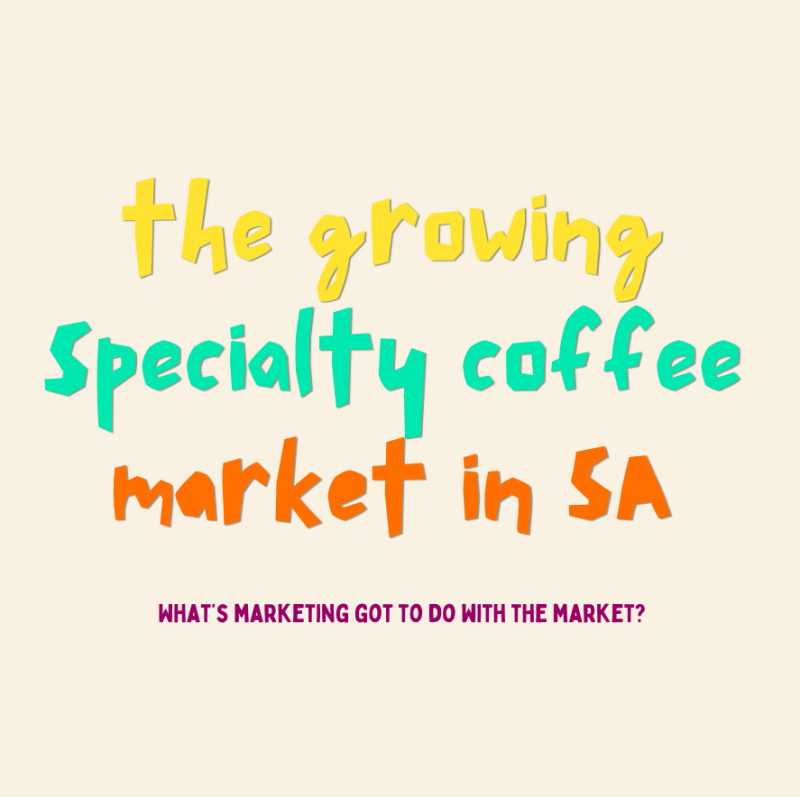Words by Katie Burnett

Over the past few years, specialty coffee in South Africa has grown substantially. Not only in width, but in depth too. The number of South African consumers interested in specialty coffee is growing and existing specialty coffee customers have become more informed.
WHY THE GROWTH?
It’s an age-old tale to hear about good versus bad coffee. “The coffee shop on the corner serves bad coffee and the one down the road serves good coffee,” but do we actually understand what we mean by that? What makes it good? What makes it bad? There’s always been an interest in finding good coffee, as you would expect, but there seems to have been a shift towards understanding what that actually means. Raw product, skills, preparation and service all have a part to play. But when it comes to choosing your next bag of coffee beans for home, with no shortage of options on the market, roasters need to use intelligent marketing to set themselves apart.
There’s no question that Youtubers and influencers like James Hoffman (2.15 million subscribers on YouTube) and Lance Hedrick (280k subscribers on YouTube) have brought specialty coffee into more homes than ever before, making a great deal of information accessible with a click of a button. Their large followings indicate an overall interest in specialty coffee and a fascination with the dynamics of the coffee in our cups. This has also become true for the South African specialty coffee consumer, giving our coffee culture same-time updates on coffee trends and information.
There’s also just greater access to specialty coffee. Over the last 10 years, South Africa began to import more specialty-grade coffees from Africa, Central and South America. This was led by the first couple of specialty coffee roasteries in South Africa. Green coffee importers began to import a couple of bags of specialty-grade coffee here and there, making them available to small South African roasteries. In an industry dominated by large roasteries pumping out hundreds of tons of commodity coffee, this was a change for coffee customers, giving them access to specialty flavours. Simply put, specialty coffee grew because it was more available on retail shelves. With this, consumers became more informed about specialty coffee, asking more questions of their local roaster.
HOW DOES THIS CHANGE THE MARKET FOR ROASTERIES?
With this growth in customer base and increased customer knowledge, coffee roasteries approach to marketing has had to change. Short form, catchy content doesn’t have the same effect that it used to. Gimmicky, novelty marketing isn’t going as far.
A customer has hard hitting questions about where their coffee comes from, how it’s roasted and the additional services (brew recipes, origin information etc.) that their roastery can provide them. Aesthetic appeal and trendiness are still as important as ever, but this is no longer the way to retain customers long term. Long form content used to be a big “no go” for marketing, but the rules are changing for specialty coffee. With such an extensive plethora of information available, and a more informed customer base, the customer is demanding more from their coffee suppliers. If you have the information, they want it. Substance and transparency are more important than ever for roasteries, and communicating this effectively is what sets each one apart in the market.
Customers are leading the charge in the quality of their coffee and information they demand, it is up to roasteries to move with them. Opportunities like the Specialty Coffee Expo allow the coffee consumer to engage with and ask questions of many roasteries in one place. And online platforms like Cape Coffee Beans, Not Bad Coffee and roasteries themselves provide choice and detailed information to consumers and this is growing all the time. As Patrik Rolf said recently at Creative Coffee Week, you can't be better than industry you're in, so it's important that messaging or marketing is also community based, the more specialty coffee roasters there are, the more space there is for growth.
Sadly, specialty coffee has become rarer to find over the past year as the commodity price of coffee has skyrocketed and South African coffee roasteries have been forced to absorb huge cuts to profit margins or to lower the quality of the coffee they buy in order to meet their market at similar prices to what they’ve always expected. They've had to focus on price more heavily. Consumers are not blind to the difference.
It is an exciting time for specialty coffee in South Africa, and it is quickly becoming a case of roasteries not being able to keep up with their customers. Specialty coffee consumers are expecting more from their coffee suppliers, and it’s an opportunity for the industry as a whole to meet them there. It will be interesting to see where this trend takes us and how the industry can respond. Optimistically, we are looking at a bright future as coffee gets better and better in South Africa.